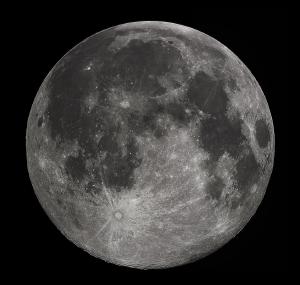Blog
Best Face Forward
6 January 2014
 Gregory H. Revera
Gregory H. ReveraThere is one side of the moon that we always see, and one side that most people have only seen in photographs. This is because the moon is tidally locked, meaning that one side of the Moon always faces the Earth.
The term “tidally locked” is a bit of a misnomer. There is nothing locking one side of the Moon toward the Earth. It just happens that the time it takes the Moon to orbit the Earth, and the time it takes the Moon to rotate once on its axis are the same. So as the Moon orbits the Earth it rotates on its axis at the same rate, and the same side of the Moon always faces us.
Part of what makes this possible is the near circular nature of the Moon’s orbit. If the Moon’s orbit were more elliptical, the faster and slower motion of the Moon in its orbit wouldn’t allow its rotation to sync with its orbit. This is the case for Mercury, which orbits the Sun twice for every “day” on Mercury. What also makes it possible is the way gravity acts upon non-spherical bodies.
Gravity acts more strongly upon closer objects than more distant objects (following the inverse-square law). This means that the side of the Moon facing the Earth is gravitationally pulled a bit more strongly than the side away from the Earth. If the Moon were perfectly spherical that wouldn’t matter, but the Moon isn’t perfectly spherical. Because of the difference in gravitational attractions, the Moon bulges slightly, and that means it has a tendency to align one side toward the Earth. This is known as tidal effect. Over time, the preferential alignment of the Moon has caused the Moon to become tidally locked with the Earth.
You can see a similar effect with a rolling wheel. If you have a bicycle tire rolling along the ground, it will roll on a flat surface at a uniform rate. But if you add a small weight to one of the spokes, making the tire lopsided, the wheel won’t roll at a uniform rate. Instead it will lurch forward until the weight is toward the bottom, then slow down as the weight is rotated upward. This lurch-slow-lurch-slow motion is due to the fact that the wheel would like to be aligned with the weight toward the bottom.
Before the Moon’s rotation was in sync with its orbit, the tidal forces would cause the Moon’s rotation to lurch-slow-lurch-slow slightly, until over time its rotational speed matched its orbital speed. The same forces act on the Earth, but since the Earth is larger than the Moon the effect is much smaller, so there hasn’t been time for the Earth to become locked to the Moon. A similar effect occurred with Pluto and its largest moon Charon. In this case, since Charon and Pluto are more similarly sized, the two have become tidally locked to each other.
So the next time you look at the familiar face of the Moon, remember the gravitational dance that got the Moon to put its best face forward.